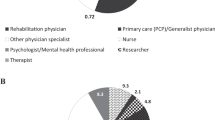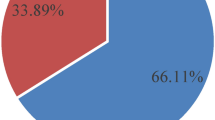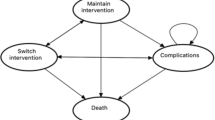Abstract
Aims:
The majority of patients with spinal cord injury (SCI) will develop neurogenic lower urinary tract dysfunction (NLUTD). These patients require a long-term urological follow-up. The follow-up protocol has varied across SCI units in the United Kingdom and Eire. We reviewed the long-term management in the SCI units to identify changes in practice over a decade and compared them to current guidelines.
Methods:
We present results of a review of all SCI centres in the United Kingdom and Eire on their long-term urological management before and after the current guidelines and compared the results with European Association of Urology (EAU) Guidelines on NLUTD and the proposed British guidelines for the urological management of patients with SCI. Data were collected through questionnaires posted to SCI units.
Results:
SCI patients are followed up in outpatients annually in the SCI centres and the frequency of follow-up remains largely unchanged. More SCI units perform renal tract imaging annually as a part of SCI follow-up. Most units follow the proposed British guideline indications for urodynamics and do not perform ‘routine urodynamics’.
Conclusions:
We conclude that the long-term management of SCI patients in SCI units in the United Kingdom and Eire has changed overtime to follow the proposed British guidelines. EAU guidelines offer a more extensive follow-up regime. Last, there is a continued lack of high-quality evidence to support an optimal long-term follow-up protocol. Importantly, there is a lack of evidence on clinical outcomes when these guidelines have been followed.
Similar content being viewed by others
Log in or create a free account to read this content
Gain free access to this article, as well as selected content from this journal and more on nature.com
or
References
Sekhon LH, Fehlings MG . Epidemiology, demographics and pathophysiology of acute spinal cord injury. Spine 2001; 15: 2–12.
Burns AS, Rivas DA, Ditunno JF . The management of neurogenic bladder and sexual function after spinal cord injury. Spine (Phila Pa 1976) 2001; 26: 129–136.
Frankel HL, Coll JR, Charlifue SW, Whitenneck GG, Gardner BP, Jamous MA et al. Long-term survival in spinal cord injury: a fifty year investigation. Spinal Cord 1998; 4: 266–274.
Sto¨hrer M, Blok B, Castro-Diaz D, Chartier-Kartler E, Del Popolo G, Kramer G et al. EAU Guidelines on Neurogenic Lower Urinary Tract Dysfunction. Eur Urol 2009; 56: 81–88.
Abrams P, Agarwal M, Drake M, El-Masri W, Fulford S, Reid S et al. A proposed guideline for the urological management of patients with spinal cord injury. BJU Int 2008; 101: 989–994.
Cameron AP, Rodriguez GM, Schomer KG . Systematic review of urological followup after spinal cord injury. J Urol 2012; 187: 391–397.
Bycroft J, Hamid R, Bywater H, Patki P, Craqqs M, Shah J . Variation in urological practice amongst Spinal Injuries Units in UK and Eire. Neurourol Urodynamics 2004; 23: 252–256.
Consortium for Spinal Cord Medicine. Bladder Management for Adults with Spinal Cord Injury. A clinical practice guideline for health- care providers. Consortium for Spinal Cord Medicine, Paralysed Veterans of America 2006; 29: 527–573.
Groah SL, Weitzenkamp DA, Lammertse DP, Whiteneck GG, Lezotte DC, Hamman RF . Excess risk of bladder cancer in spinal cord injury: Evidence for an association between indwelling catheter use and bladder cancer. Arch Phys Med Rehabil 2002; 83: 346–351.
Trautner BW, Darouiche RO . Prevention of urinary tract infection in patients with spinal cord injury. J Spinal Cord Med 2002; 25: 277–283.
DeVivo MJ, Fine RR, Cutter GR, Maetz HM . The risk of bladder calculi in patients with spinal cord injuries. Arch Intern Med 1985; 145: 428–430.
Shingleton WB, Bodner DR . The development of urologic complications in relationship to bladder pressure in spinal cord injured patients. J Am Paraplegia Soc 1993; 16: 14–17.
Dunn M, Love L, Revesloot C . Subjective health in spinal cord injury after outpatient health care follow-up. Spinal Cord 2000; 38: 84–91.
Canupp KC, Waites KB, DeVivo MJ, Richards JS . Predicting compliance with annual follow up evaluations in persons with spinal cord injury. Spinal Cord 1997; 35: 314–319.
Bodley R . Imaging in chronic spinal cord injury – indications and benefits. Eur J Radiol 2002; 42: 135–153.
Burki JR, Abdul-Rahman A, Hamid R, Shah PJR . Significance of upper tract abnormalities identified on ultrasound during followup of neurogenic bladder patients. Poster no 6, BAUS Annual Meeting 2011 Published in BJU International 108: 18–60.
Bih LI, Tsai SJ, Tung LC . Sonographic diagnosis of hydronephrosis in patients with spinal cord injury: influence of bladder fullness. Arch Phys Med Rehabil 1998; 79: 1557–1559.
Vaidyanathan S, Hughes PL, Soni BM . A comparative study of ultrasound examination of urinary tract performed on spinal cord injury patients with no urinary symptoms and spinal cord injury patients with symptoms related to urinary tract: do findings of ultrasound examination lead to changes in clinical management? Sci World J 2006; 6: 2450–2459.
Wyndaele JJ . Correlation between clinical neurological data and urodynamic function in spinal cord injured patients. Spinal Cord 1997; 35: 213–216.
Foley SJ, McFarlane JP, Shah PJ . Vesicoureteric reflux in adult patients with spinal injury. Br J Urol 1997; 79: 888–891.
Edokpolo LU, Foster HE Jr . Renal tract ultrasonography for routine surveillance in spinal cord injury patients. Top Spinal Cord Inj Rehabil. Winter 2013; 19: 54–60.
Linsenmeyer TA, Linsenmeyer MA . Impact of annual urodynamic evaluations on guiding bladder management in individuals with spinal cord injuries. J Spinal Cord Med 2013; 36: 420–426.
Patki P, Woodhouse J, Hamid R, Shah J, Craggs M . Lower urinary tract dysfunction in ambulatory patients with incomplete spinal cord injury. J Urol 2006; 175: 1784–1787 discussion 1787.
Warwick RT, Whiteside CG, Arnold EP, Bates CP, Worth PH, Milroy EG et al. A urodynamic view of prostatic obstruction and the results of prostatectomy. Br J Urol 1973; 45: 631–645.
Esclarin DR, Garcia LE . Herruzo CR. Epidemiology and risk factors for urinary tract infection in patients with spinal cord injury. J Urol 2000; 164: 1285–1289.
Siroky MB . Pathogenesis of bacteriuria and infection in the spinal cord injured patient. Am J Med 2002; 113: 67–79.
Author information
Authors and Affiliations
Corresponding author
Ethics declarations
Competing interests
Mr R Hamid is an advisor and lectures for Allergan, Pfizer and Astellas, Mr J Shah is an advisor and lectures for Pfizer, Allergan and AMS. The remaining authors declare no conflict of interest.
Appendix
Appendix
Audit of urological management of patients with spinal cord injuries in spinal injury units in the UK and Eire

Rights and permissions
About this article
Cite this article
Burki, J., Omar, I., Shah, P. et al. Long-term urological management in spinal injury units in the UK and Eire: a follow-up study. Spinal Cord 52, 640–645 (2014). https://doi.org/10.1038/sc.2014.90
Received:
Accepted:
Published:
Issue date:
DOI: https://doi.org/10.1038/sc.2014.90
This article is cited by
-
Literature Review: Long-Term Complications of the Neurogenic Bladder
Current Bladder Dysfunction Reports (2015)



